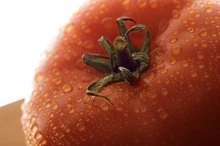Foods Containing High Levels of Nitrates
Nitrates are inorganic ions that make their way into plant foods from the soil they grow in. They are also added to many processed foods. Excess nitrates in certain foods you consume may affect your health, but it is not yet determined what a safe amount is. How often you eat foods high in nitrates, the amount these foods consumes and whether you have certain diseases, all impacts whether the nitrates in foods negatively affect you.
Occurrence
Nitrates form from the decomposition of nitrogen-rich waste present in soil and water. Plants that come into contact with nitrate-rich soil or water contain varying levels of nitrates. When farmer's add fertilizers with nitrates to crops, some of the nitrates move from the soil into the plants. The New Hampshire Department of Environmental Services indicates that the the average nitrate intake from vegetables for an adult is between 75 and 100 milligrams a day.
- Nitrates form from the decomposition of nitrogen-rich waste present in soil and water.
Processed Meats
Reheating Cooked Vegetables & Nitrates
Learn More
Food manufacturers often add nitrates to processed meats such as hot dogs, luncheon meat, bacon, ham and sausages to enhance their color and shelf-life. A study featured in the May 2010 edition of the journal "Circulation" drew a correlation between processed meats high in nitrates and the risk of diabetes, stroke and heart disease. Another study published in the March 1994 edition of "Cancer Causes and Control" found a link between how often pregnant women consumed hot dogs and the incidence of brain tumors in their children, as well as a link between hot dog consumption and brain tumors in small children. If you choose to consume processed meat, limit your consumption to once or twice a month, or purchase nitrate-free varieties.
- Food manufacturers often add nitrates to processed meats such as hot dogs, luncheon meat, bacon, ham and sausages to enhance their color and shelf-life.
- A study featured in the May 2010 edition of the journal "Circulation" drew a correlation between processed meats high in nitrates and the risk of diabetes, stroke and heart disease.
Vegetables
Vegetables can contain nitrates, and over 70 percent of the nitrates the average adult consumes comes from nitrates in natural foods, according to the Agency for Toxic Substances and Disease Registry. The agency indicates that nitrate-rich vegetables do not normally give you dangerous levels of nitrates. Root vegetables, such as potatoes or carrots, contain more nitrates than plants grown above the ground. Other vegetables often higher in nitrates include spinach, broccoli and cauliflower. Additionally, any produce that comes in contact with either nitrate-rich fertilizer or animal feces contaminated with nitrates, may contain high levels of nitrates.
- Vegetables can contain nitrates, and over 70 percent of the nitrates the average adult consumes comes from nitrates in natural foods, according to the Agency for Toxic Substances and Disease Registry.
- Additionally, any produce that comes in contact with either nitrate-rich fertilizer or animal feces contaminated with nitrates, may contain high levels of nitrates.
Water
How Nitrates & Nitrites Affect Our Bodies
Learn More
Agency for Toxic Substances and Disease Registry also advises that nitrates can contaminate some drinking water supplies. The agency notes that about 1.2 percent of wells in small communities and 2.4 percent of wells on private land have unacceptable levels of nitrates in the water. Rural areas that are rich in agricultural farming often have higher incidences of nitrate contamination. Infants who consume formula or baby food made with nitrate-rich water risk developing blue-baby syndrome. According to research published in the July 2000 issue of "Environmental Health Perspectives," this syndrome can cause severe illness and even death, if it is not treated promptly.
- Agency for Toxic Substances and Disease Registry also advises that nitrates can contaminate some drinking water supplies.
Related Articles
References
- Centers for Disease Control and Prevention; Agency for Toxic Substances & Disease Registry; Nitrate/Nitrite Toxicity What Are Nitrate and Nitrite?; September 2007
- "Cancer Causes and Control"; Cured and Broiled Meat Consumption in Relation to Childhood Cancer: Denver, Colorado (United States); S. Sarasua, et al.; March 1994
- "Circulation"; Red and Processed Meat Consumption and Risk of Incident Coronary Heart Disease, Stroke, and Diabetes Mellitus; Renata Micha, et al.; May 2010
- "Environmental Health Perspectives"; Blue Babies and Nitrate-Contaminated Well Water; Lynda Knobeloch, et al.; July 2000
- Agency for Toxic Substances and Disease Registry. ATSDR Case Studies in Environmental Medicine Nitrate/Nitrite Toxicity. 2013.
- Agency for Toxic Substances and Disease Registry. Nitrates/nitrites poisoning patient education care instruction sheet.
- Agency for Toxic Substances and Disease Registry. Nitrate/Nitrite Toxicity What Are U.S. Standards and Regulations for Nitrates and Nitrites Exposure? Updated August 9, 2016.
- Alshahrani SM, Fraser GE, Sabaté J, et al. Red and Processed Meat and Mortality in a Low Meat Intake Population. Nutrients. 2019;11(3):622. doi:10.3390/nu11030622
- Zhang Y, Zhao G, et al. Nitrite accumulation during storage of tomato fruit as prevented by hydrogen gas. International Journal of Food Properties. 2019;22(1):1425-1438. doi:10.1080/10942912.2019.1651737
- Jackson JK, Patterson AJ, Macdonald-Wicks LK, et al. Dietary Nitrate and Diet Quality: An Examination of Changing Dietary Intakes within a Representative Sample of Australian Women. Nutrients. 2018;10(8):1005. doi:10.3390/nu10081005
- Machha A, Schechter AN. Inorganic Nitrate: A Major Player in the Cardiovascular Health Benefits of Vegetables? Nutr Rev. 2012;70(6):367-372. doi:10.1111/j.1753-4887.2012.00477.x
- Agency for Toxic Substances and Disease Registry. Toxic Substances Portal — Nitrates and Nitrites. Updated November 23, 2015.
- Lidder S, Webb AJ. Vascular Effects of Dietary Nitrate (as Found in Green Leafy Vegetables and Beetroot) via the Nitrate-Nitrite-Nitric Oxide Pathway. Br J Clin Pharmacol. 2013;75(3):677-696. doi:10.1111/j.1365-2125.2012.04420.x
Writer Bio
Diane Lynn began writing in 1998 as a guest columnist for the "Tallahassee Democrat." After losing 158 pounds, she wrote her own weight-loss curriculum and now teaches classes on diet and fitness. Lynn also writes for The Oz Blog and her own blog, Fit to the Finish. She has a Bachelor of Science in finance from Florida State University.









